Access to safe, affordable, and diverse housing options is essential for a thriving and inclusive Kenosha County. The Livable Kenosha Coalition, a collaboration of local leaders, organizations, and community advocates, created a community survey to better understand the housing needs, challenges, and opportunities in Kenosha County for elders and individuals with disabilities. The responses from this survey informed a comprehensive housing report, which examines key trends in affordability, accessibility, and availability. The report is available at the bottom of the page.
This webpage highlights key findings from the report, providing valuable data on rental affordability, homeownership trends, zoning considerations, and innovative housing solutions. By making this information accessible, we aim to support policymakers, developers, and residents in shaping a more inclusive, affordable, and sustainable housing future for Kenosha.
Explore the sections below to learn more about the state of housing in Kenosha and how we can work together to create lasting solutions.

The Livable Kenosha Coalition brings together community leaders, organizations, and residents committed to improving housing accessibility and affordability in Kenosha County. Through research, collaboration, and advocacy, the coalition seeks innovative solutions to address local housing challenges.
The Livable Kenosha Coalition conducted a community survey to gain insight into the housing needs and preferences of residents across Kenosha County. Adapted from an AARP survey, it aimed to gather input from people of all ages, income levels, and municipalities, with a focus on identifying gaps in housing options for older adults and individuals with disabilities. The survey also explored residents’ current housing situations and their future housing plans over the next 5, 10, and 15 years.
To maximize participation, the survey was offered both online and in print at key locations. A QR code linking to an electronic version of the survey was shared through posters, websites, and social media, with versions available in English and Spanish.

A remarkable total of 401 surveys were completed, significantly exceeding the initial target of 275 responses. The feedback gathered offered crucial insights into the housing requirements and plans of residents in Kenosha County, especially for those aged 65 and older. The survey results indicated that 62% of participants were over 65 years old, 28.3% identified as having a disability, and 22% reported being caregivers.
AGE BREAKDOWN
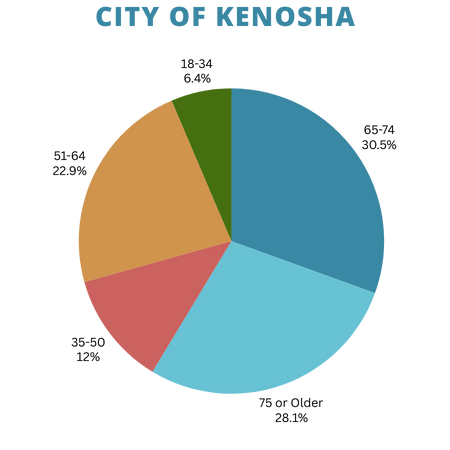
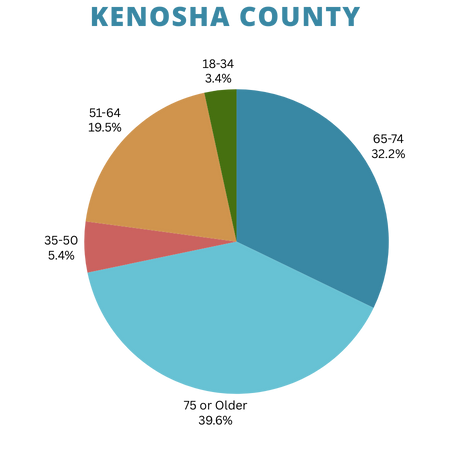
DISABILITY & CAREGIVING
Of those who completed the survey, 28.3% identified as a person with a disability, highlighting the importance of including accessible, inclusive housing options in future planning efforts. This significant representation underscores the need to consider the unique perspectives and challenges faced by individuals with disabilities when shaping Kenosha County’s housing strategies.

Among survey respondents, 23% of City residents and 18% of County residents identified as caregivers – emphasizing the need for housing solutions that support multigenerational and caregiving households.
Among caregivers in both the city and county, the majority were caring for an adult child with a disability. The next largest category in the city was caregivers of a spouse or significant other, whereas in the county, caregivers of a spouse or significant other and caregivers of parents were tied for second largest group.
Caregivers play a vital role in supporting family members with disabilities or age-related needs, often balancing this responsibility alongside work and other commitments. The survey revealed that caregivers frequently face challenges related to affordable and accessible housing, transportation, and home modifications – highlighting a critical need for resources and policies that better support their efforts.
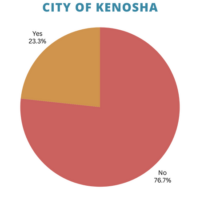
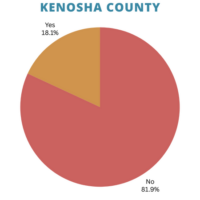
HOUSING PLANS

Survey results revealed that while a majority of respondents had clear housing plans for the next 5 years, significantly fewer had plans in place for the next 10 or 15 years. This suggests that many residents are focused on their immediate housing needs but may not be thinking long-term—particularly when it comes to aging in place or accommodating future accessibility challenges. The findings highlight a need for increased education and planning support to help individuals and families prepare for changing housing needs over time.
WHY MOVE?
Survey respondents highlighted several important factors that would influence their decision to move from their current home. The most cited reason was the availability of support, underscoring the importance of having help nearby when needed. Other top considerations included the cost of maintaining their home and how physically accessible it is. While location mattered to many, it was less of a priority compared to support systems, affordability, and ease of living – especially for those planning for future health or mobility changes.
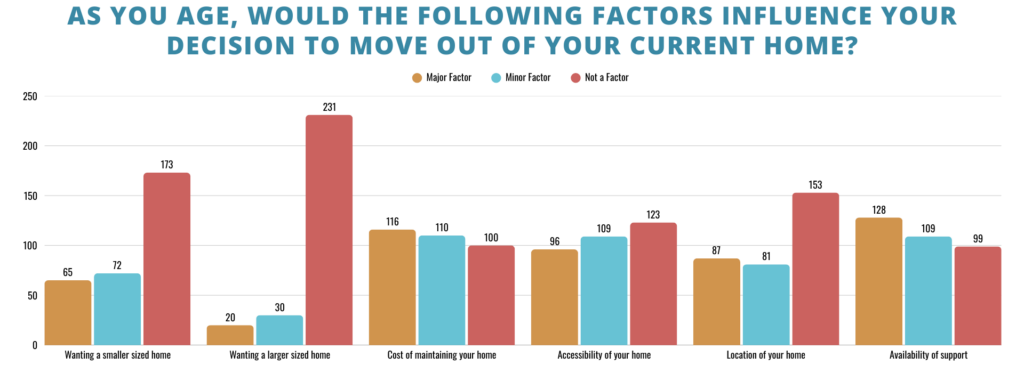
Home sharing emerged as a potential housing solution in the survey. Many respondents said they would consider sharing their home with family members, while fewer were open to sharing with friends. Most indicated they would not feel comfortable sharing their home with a stranger.
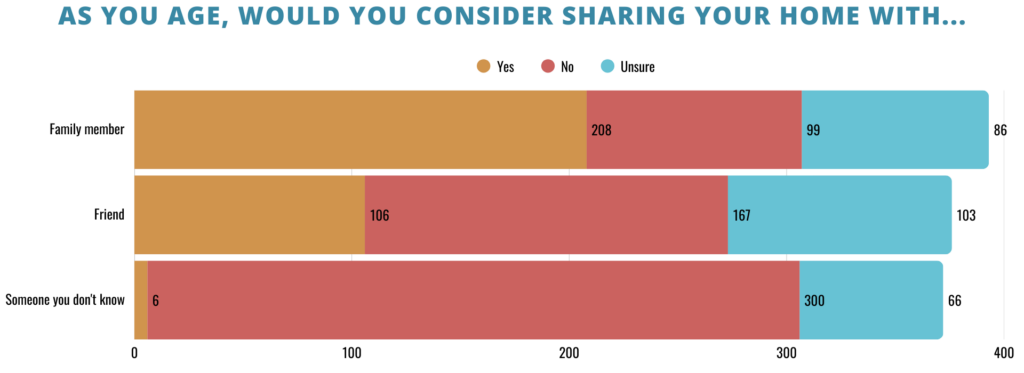
IDEAL LIVING ARRANGEMENTS
Respondents were asked to share what types of housing need to be developed in Kenosha to meet your future needs. The majority of respondents indicated that Kenosha should focus on developing social communities, supported housing, and linked living.
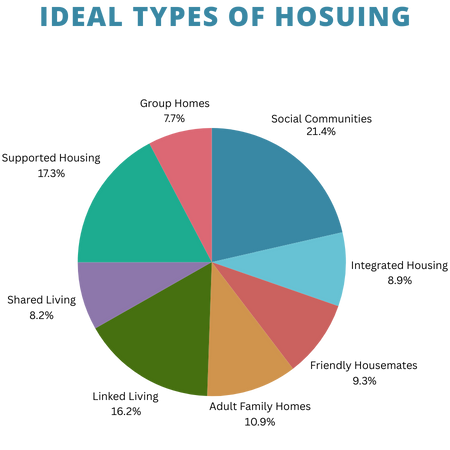
Linked Living provides some independence and autonomy with the security of family nearby.
Shared Living individuals share housing along with chores such as cooking, cleaning and shopping.
Supported Housing allows people with disabilities to live on their own and receive available subsidized rental rates.
Group Homes provide housing and up to 24/7 support for people with varying levels of need.
Adult Family Homes generally equipped to deliver more individual support in a setting where individuals feel like a “member of the family.”
Friendly Housemates living in a house or apartment with a roommate who is a friend and caregiver.
Integrated Housing houses residents with disabilities within a housing community, apartment, or individual home where most residents do not have a disability.
Social Communities bring together people with similar goals, beliefs, interests or other attributes together, transforming integrated housing into a social community.
When asked about ideal housing, most respondents emphasized maintaining independence with support as needed. Many preferred small, accessible homes—such as ranch-style houses with no steps, attached garages, and ADA or Universal Design features. Some were interested in Accessory Dwelling Units (ADUs) or attached suites for family. Pet-friendly housing and proximity to public transportation, medical care, and social activities were also important.
Caregivers echoed the need for accessible, affordable housing with flexible living arrangements and transportation options, highlighting the importance of independence and opportunities for social connection.
HOUSING FOR CHILDREN WITH DISABILITIES
Many survey respondents identified as caregivers for a child with a disability, yet only a small percentage reported having a long-term housing plan in place. Parents expressed a strong desire for their loved ones to live as independently as possible, with safety and support as top priorities. Preferred housing options included group homes, supported housing, and adult family homes. Respondents emphasized the need for flexible supports, homelike environments, and housing located near family – ideally within Kenosha County.


Kenosha’s aging population is expected to grow rapidly, with those over 65 becoming the fastest-growing demographic. Survey data shows that about one-third of respondents identified as having a disability, and 23% of city respondents and 18% of county respondents are caregivers. These statistics highlight the need to include older adults and individuals with disabilities in future housing plans. The following are the Livable Kenosha Coalition’s recommendations for addressing these needs in housing strategies.
Addressing the Cost of Living & Housing Accessibility
To address housing affordability concerns, it is recommended that future housing development prioritize affordability and community integration for seniors, individuals with disabilities, and low-income residents. This includes increasing the availability of ADA-compliant housing and incorporating universal design features that promote accessibility and social interaction, particularly in areas outside of the City of Kenosha.
Focus on Low-Income Housing Solutions
To address the challenges faced by low-income residents, particularly older adults and individuals with disabilities, it is recommended to increase funding and support for affordable housing initiatives, especially in areas west of I-94 where the housing shortage is more acute. Developers should be incentivized to create accessible housing and local programs should expand to provide financial assistance for security deposits and moving costs, which are significant barriers for low-income renters.
Improving Public Transportation and Accessibility
To improve mobility for older adults and individuals with disabilities, it is recommended that the city assess and enhance public transportation services, ensuring bus routes are connected to housing developments and essential services. Additionally, increasing the availability of well-maintained, sheltered bus stops, improving sidewalk maintenance, and creating more accessible parking should be prioritized to support residents with physical challenges.
Enhancing Housing Options for Middle-Income Residents
To address the housing needs of middle-income residents, it is recommended to develop more “Missing Middle Housing” options, such as 2-3 bedroom homes with universal design features like no steps, wider doorways, and sheltered parking. These homes should be located near essential services like grocery stores, pharmacies, and medical facilities to attract both older adults and younger professionals with disabilities.
Supporting Individuals with Disabilities and Caregivers
To address the diverse housing needs of individuals with disabilities, it is recommended to increase the availability of supported housing options in Kenosha County, including independent-living apartments with supportive services, group homes, adult family homes, and linked/shared living arrangements. These options should prioritize keeping individuals with disabilities close to their families and communities to maintain independence and social connections. Additionally, expanding senior care communities that offer gradual transitions from independent living to higher levels of care will provide more sustainable solutions for caregivers and their loved ones.
Addressing NIMBY and Community Resistance
To overcome the “Not In My Back Yard” (NIMBY) mentality, it is recommended that local leaders initiate proactive education campaigns that engage the community and address misconceptions and concerns about new housing developments. By highlighting successful housing projects in similar communities, Kenosha can build support and reduce resistance, fostering a more welcoming environment for necessary housing initiatives.
Enhancing Housing for the High-Income Population
For higher-income individuals, the main challenge is the limited availability of smaller homes with high-end amenities. Many in this group are reluctant to move due to a lack of housing options that meet both size and location preferences. It is recommended that the city attract developers to build high-quality homes with modern amenities. This would help retain wealthier residents and increase property tax revenues, which can be reinvested into affordable housing and community services.
A Comprehensive Housing Strategy for Kenosha
Incorporating the needs of older adults, individuals with disabilities, and low-income families into Kenosha’s housing strategy is crucial for maintaining an inclusive, thriving community. The city and county should prioritize creating livable communities that offer accessible housing, reliable public transportation, and diverse housing options for all income levels.
An important step is updating zoning laws to allow more flexible housing solutions, such as ADUs, duplexes, and shared living arrangements. Current zoning restrictions often limit homeowners’ ability to add ADUs or modify properties for multi-generational or shared living, which can help ease housing shortages.
Additionally, increasing public education on traditional and alternative housing models is vital. Many residents may be unaware of options like linked living, the village model, and other innovative solutions. Offering educational resources, workshops, and outreach initiatives can help residents make informed housing decisions and advocate for policies that support sustainable, diverse housing solutions.
By adopting a proactive approach that includes zoning reforms and increased education, Kenosha can build a more sustainable and inclusive community that meets the needs of residents, regardless of age, ability, or income.



